 |
|
|
Oberheim Matrix 1000 The analog Matrix 1000 is essentially 1,000 Matrix 6 patches in a single-space compact rackmount MIDI module. It has the same synth architecture as the Matrix 6. Each of its 6 voices have two DCO's (digitally controlled analog oscillator), a low pass filter, 2 VCA's, 3 envelope gens, 2 LFO's, and 2 ramp gens. The sounds are plentiful and good enough, however if you want to edit your own, you'll need a Matrix 6/6R or some universal editor (such as MOTU's Unisyn) to externally edit parameters. You can also load sounds from the Matrix 6 via SysEx or software. The Matrix 1000 provides an excellent source of pads, textures and ambient sounds. It has 195 "keyboard" sounds, 118 "strings", 130 "woodwinds & perc", 239 "synthesizer", 119 "bass", 74 "lead" and 125 "effects". For the price, there is no better way to find genuine analog Oberheim Matrix sounds in a compact and very in-expensive rack module that is loaded with more sounds than you'll ever need! The older versions of the Matrix 1000 have a black front-panel. The newer models in the '90's have a cream face-plate. It has been used by Apollo 440, Juno Reactor, Moby, Cirrus, Fatboy Slim, Laurent Garnier, ATB, Depeche Mode, Future Sound of London, Pet Shop Boys, and Faithless. Roland JX3P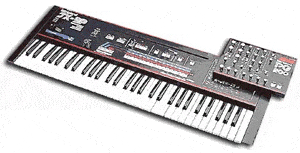 The JX-3P is a pretty good synth, best known for a good string sound. It came about at the same time as the Juno series but represents a shift towards digital circuitry, push-buttons and (for the JX-3P) simplified programming. Compared with a Juno, the JX-3P sounds inferior however it is analog and capable of decent synth sounds for cheap. You will need the PG-200 programmer if you want real control of it. It's a six voice polyphonic with two DCO's per voice which means analog oscillators and sounds with digital stability and control. The typical assortment of filter, envelope, LFO and oscillator sections are here with easy and straight-forward programming. Surprisingly, the JX-3P is MIDI equipped, in fact it was Roland's first MIDI synth but was very limited to basic note on/off information only. Synths like the Juno 106 have far better MIDI implementation and sounds. Although the JX-3P may not be as nice or professional as a Juno, it makes a great entry level Vintage synth capable of creating some useful classic analog sounds. The JX-3P also came in a rack-mount version called the MKS-30. It has beenused by The Future Sound of London, Astral Projection, Vince Clarke, Orbital, Luke Vibert, Stevie Nicks, and Thomas Dolby. Polyvox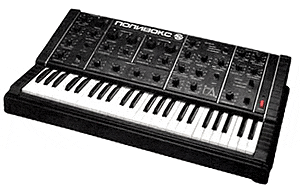 Polivoks is the portable electronic musical synthesizer which is designed for playing different musical compositions of any genre. It is also intended for creating some musical effects in cinema and play scoring, in studio. There are 4 octaves on the keyboard. The inclined desk is divided into the following functional sections: Modulator, Generator #1, Generator #2, Mixer and Amplifier. They give one a possibility to synthesize a broad spectrum of sounds and to change sounding at any time. There are 3 internal audible signal sources in the instrument: to broad-ranged of the Generators with changed form of oscillations and a noise generator for creating a non-musical sounds such as wind, surf, whine, etc. Possibility to connect an external audible signal sources to the synthesizer is provided for (e.g. guitars, electropianos and electroorgans). Sounds of different external sources are combined separatly in the mixer in any ratio. There is a filter in the synthesizer with cutoff frequency control and resonance to change colour of timbre of audilble signal over a wide range. Junost-21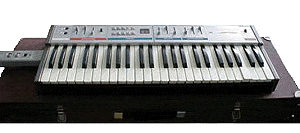 Unost' - 21 is a portable polyphonic keyboard EMI. A player can hang it on a shoulder. Timbre of sound can be changed in accordance with players desire by the use of controls or choosing one or 12 programed timbres with digital indication of chosen one. The instrument changes sounding during playing composition using such effects as chorus, unison, transposition with continuous and coarse control, frequency and timbre vibrato with continuous frequency, depth and delay time control, fixed and dynamic change of timbre, attack and fading of sound. Attack, fading and level of envelope of the filter. Filter's cutoff frequency control from the keyboard. The case of the instrument is made out of aluminium. Control panels are made out of shockproof polystyrene. Power unit is made as an individual part. There is a leather belt to hang the instrument on a shoulder. There is a special case out of veneer for carrying purposes. There is a possibility to plug a power source with voltage within +/- 10 V in a socket. Aelita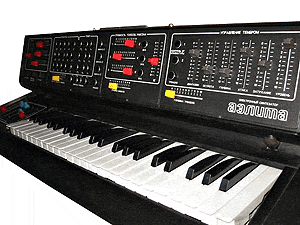 Electric musical synthesizer Aelita (Murom plant RIP). This monophonic synthesizer with 3 oscillators is a modern musical instrument. If a player uses different musical effects (for example three-part unison, timbral glissando, frequency vibrato, timbre tremolo, decay, attack, strings.) a composition would sound in a new fashion. Sounding may be changed during the playing as well as timbre: special controls are provided for it. There is a possibility to record sounding on a tape during playing composition. This instrument can be successfully used in a variety ensembles. The elegent package made out of aluminium alloy and is covered with artificial leather. It is well protected by the light and firm case. Yamaha TG77 The TG-77 is like having a super-sized sample-memory workstation with the added synthesis and sounds of a DX-7mkII. For its synthesizer section it employs a 6 operator FM synth engine similar to, if not better than, the original DX's. The FM section offers 45 algorithms, 3 feedback loops and 16 waveforms for creating some of those unique FM sounds. Sampled sounds (AWM) which are in memory (or on external ROM cards) can then be mixed with the FM sounds to create entirely wild new sounds! And these sounds are quite shapeable thanks to the resonant multi stage Time Variant Filters which offer the chance to recreate the warm analog sounds of classic synths, or create something entirely new. It's used by 808 State, Skinny Puppy, Brian Eno, and Front 242. Yamaha TX81ZYet another FM synthesizer from Yamaha, this one comes in a compact, multitimbral, 1-unit rackmount module and is basically a key-less version of the DX-11. The TX81Z features great FM type synth sounds similar also to the DX-21 and DX-27. It's still not as good as the classic DX-7, but it's an inexpensive source of those sounds with lots of programmability. Eight voice polyphony, 128 preset sounds, 32 user and lots of functions hidden behind 11 push buttons. The TX81Z features a new ability to use waveforms other than just a sine wave. There are eight voices that can be split, layered and detuned. Also onboard are pseudo-effects including delay and reverb. These features can be stored as performance setups. The effects are simply envelope and re-triggering effects. The TX81Z works great as a sound-module for any live or studio production. It's got a wider range of sounds than the DX-7, may not be quite as warm or 'classic' sounding, but at its low price and with the excellent MIDI implementation it makes a great alternative or backup synth for percussive, punchy FM synth sounds. It's used by Fluke, Roni Size, Astral Projection, Squarepusher, Future Sound of London, and Josh Wink. Casio CZ1 The CZ-1 competes with the CZ-5000 for the best all around Phase Distortion digital synth. The CZ-1 has the most advanced keyboard of all the CZ series synths. It has a full 61-note 5-octave keyboard with velocity and aftertouch sensitivity. Very professional features from a Casio synth! Otherwise it is essentially a CZ-3000 (which is essentially two CZ-1000s or CZ-101s). With the CZ-1 you get 8-stage envelopes, 2 oscillators per voice and a whole lot more with relatively easy programming. Whereas the CZ-5000 may not have had as good a keyboard, it had the benefit of an on-board 8-track real-time sequencer which the CZ-1 lacked. If you're looking for low-cost Yamaha DX-like sounds, the Casio CZ line of Phase Distortion synths are a good buy. For performance, the CZ-1 may be the best of the CS-series. Its dynamic keyboard and enhanced memory abilities make it ideal for live situations. Memory, MIDI and multitimbrality have all been upgraded in the CZ-1 making it one of the nicest budget synths ever to grow out of a consumer market. Casio MT-210
Another vintage synth from the great MT series. 8 bit PCM drums and accompaniments.
Ensoniq ASR-X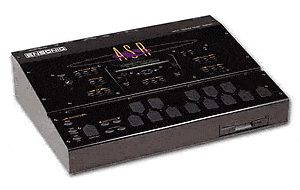 The ASR-X is a professional quality alternative to the Akai MPC-3000. It's a sampling, synthesizer, sequencer and effects studio in a single tabletop unit with professional sampler specifications, and easy yet professional sample editing features. Although it has been replaced by the ASR-X Pro, this instrument is still pretty great. For the most part, they're both the same - except the ASR-X is not as expandable. However it still has easy programming, excellent analog-like filters (low, high and bandpass with resonance), many sample-editing functions, digital effects and easy sequencing. Korg MS2000R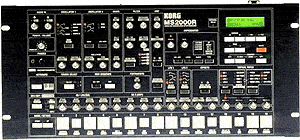 Korg MS2000R combines state of the art Analog Physical Modelling synth sounds with a very vintage Korg appearance. The Korg MS2000R features a cool "Virtual Patch" mode in which signal can be routed to various sections of the synth (ie: LFO, Filter or Keyboard Velocity) using the LCD display and paging through various screens. The MS2000R actually comes up against the similar Roland JP-8000 and Novation SuperNova & Nova synths. Despite its amazing look, the MS2000R has some surprising limitations. It has only 4-voice polyphony so you won't be creating very lush or complex pads and sounds with it. In spite of this, its sound is clean, crisp and very flexible. It can easily conjure up beefy basslines, sub-basses, wonderful sweeping leads, pads and hits. Classic features include a 6 pattern arpeggiator, a very flexible LFO with sample and hold and even vintage wood side-panels and printed block diagrams and programming data on the face. It is used by BT, Depeche Mode, Apollo 440, the Crystal Method, Placebo, and Snoop Dogg. Korg Prophecy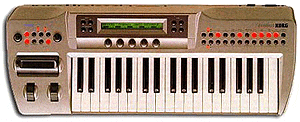 Digital does analog! This hybrid digital synth is one of the coolest new monophonic lead synths!!! Tons of real-time control over traditional analog editing parameters like cutoff, resonance, envelopes and arpeggios. And it's all at your finger tips. It has a pitch wheel, a mod wheel, and a dual action ribbon wheel, 6 effects processors and more! Plus its retro analog sounds are really good too! It is used by The Orb, Jan Hammer, Download, Meat Beat Manifesto, Mirwais, Front Line Assembly, Kobe, Depeche Mode, Orbital, Theatre, Uberzone, BT, Union Jack, The Prodigy, the Crystal Method, Eat Static, Apollo 440, Radio Head, Luke Vibert, Stabbing Westward, 808 State, the Pet Shop Boys and lots more! Roland SPD-11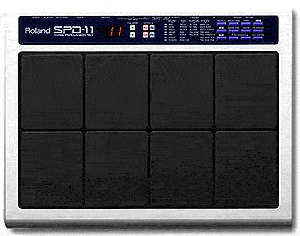 A great alternative to programming beats with a drum machine or keyboard. Not a replacement for a real drum kit, but great for getting more nuance into stiff programmed patterns. The hihat pedal is highly recommended as this gives you the most real sounding hihat next to a real hihat. It can also do double duty as a sound module too. Roland MC-505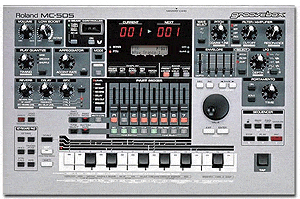 An all in one techno music production studio, this machine has it all. A massive collection of professional and coveted electronic synth and drum sounds, effects, built-in real-time VCF and envelope knobs for tweaking, a sequencer/arranger, and many other great additions. This is the successor to the MC-303 and is now much more advanced. Its sounds will be familiar to any techno-head. The LFO and resonant filters allow quick and easy sound manipulation. The new D-Beam allows you to randomly tweak your sounds by passing your hand over a laser beam! It has a great sequencer for building your songs (with groove quantizing and part level faders for mixing) as well as many idea catchers like the phrase sampler and arpeggiator. Korg N364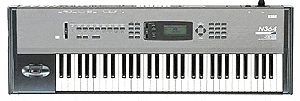 Let's face it, a musical instrument is only as good as its sounds; and themmore the merrier. The new N264 and N364 are absolutely brimming with 936 programs and combos based on 8MB of PCM ROM featuring 430 Multisounds and 215 drum sounds. And the N-Series sounds rely on Korg's renowned AI2 Synthesis System, the same system that's found in the 01/W and X-Series Music Workstations. Whether you're creating complex sequences or using rich layers of sound, the new N-Series with 64-note polyphony can keep up. RPPR, Real-time Pattern Play and Record,lets you record and save musical phrases and ideas as patterns. You can play a pattern back by simply pressing the key you've assigned it to. The N-series has 100 RPPR pattern memory locations. Use the ones that come from the factory (we think they're pretty cool), edit them, or create your own. You can even store RPPR patterns on a floppy. Native Instruments Reaktor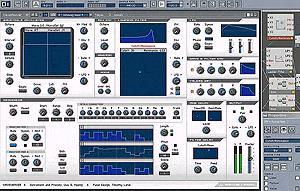 Reaktor from Native Instruments is a very flexible and great sounding software-based modular real-time synthesizer, sampler and effects processor. Select from a large library of synths/samplers or build and create your own! It functions just as any other Modular Dream machine would except that in its software environment, there are virtually unlimited amounts of flexibility, patchability and sonic possibilities. Reaktor has been used by Juno Reactor, Matmos, LFO, Depeche Mode, Kid 606, Richard Devine, Squarepusher, Autechre, Mouse On Mars, Dan Hekate, Somatic Responses, and Coldcut. Roland SH-2000 The SH-2000 is a very old and limited but funky analog synth. It has a bunch of preset sounds selected from those ugly green, red and white buttons beneath the keyboard. The sliders give you control of the filter cut-off, resonance, modulation, and sustain. Amazingly however, this 1973 synth has aftertouch which can be assigned to the filter or pitch or to the 'GROWL' sound (growling is what this synth is best for). The SH-2000 is great for squeaky effects and growling bass notes. It is used by Norman Cook (Fatboy Slim, Mighty Dub Kats). Yamaha RY-10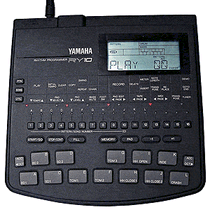 An excellent little drum machine offering excellent versatility and ease of use. Here are some of its features. . 250 AWM (sampled) drum & percussion sounds as well as bass instruments, 50 preset & 50 preset fill in patterns, 50 programmable pattern / 50 fillin memories, 36 song capacity, 12 performance buttons, 16 preset & 16 user pad banks, 28 note polyphony, 2 channel midi input (bass & drums), midi in Sync, stereo output plus headphone jacks, tape in/out, battery operation or optional AC adaptor, A line in allows connection of a guitar or bass with the sound being mixed with the RY10 output, An automatic guitar tuner is included as well. Novation K-Station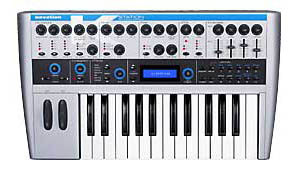 The K-Station is an extremely well laid-out and superbly designed 2-octave keyboard version of their new A-Station rack module. It features 8 voices of analog modelled sounds with FM, 12-band vocoder, arpeggiator, reverb and delay effects, 400 user rewritable program memories, and more. It has 25 knobs for real-time control, and all knobs transmit MIDI controller messages. The K-Station has three oscillators which provide sawtooth, triangle, sine, pulse width modulation and other waveforms. There's even a simple FM synth engine which can be dialed in for sharpening the sound. The K-Station is really an expressive, compact keyboard that's a hand-on joy to use and is just full of clean analog sounding synth bass, punchy leads, pads, filter sweeps and more! Rhythm Ace FR-8L Analogue rhythm machine from the early 70's. Grandfather of the legendary Roland's CR-78 and predecessor of many other cults: the TR909, TR808, TR 707, TR626. Rhythm machines from the Rhythm Ace series used by J.M.Jarre, Tangerine Dream, Vangelis. Formanta EMS-01Formanta EMS-01 is an electric music instrument combininga polyphonic organ and a monophonic synthesizer. It is designed to perform music of all genres and to create various sound effects while recording soundtracks for movies and plays, or studio recording. The organ has a 5-octave keyboard, 6 preset sound timbres, frequency vibrato with adjustable vibrato delay, decay adjustment and a stereophaser (common for organ and synthesizer). The "vibrato delay" scheme is activated again only after all the previously pressed keys are released. In the "legato" mode the "vibrato delay" scheme is not activated. The synthesizer has: 3-octave keyboard; modulator, modulation voltage from which is applied to frequency modulator, width modulator, filter, and amplifier; broad band oscillators 1 and 2 (with various waveforms); mixer, designed for summation of signals from oscillators 1 and 2, noise generator, external source, and ring modulator; filter, designed for dynamic and static changing of the spectrum of summarized signal from mixer output; amplifier, designed for making the sound corresponding to various parameters of the envelope; Visual division of the synthesizer panel into the above listed sections and their lay-out make it more easy to orientate oneself while setting the required timbre. Besides, the synthesizer is able to simultaneously control one more similar synthesizer through a special cable and connectors CONTR IN and CONTR OUT. Korg Electribe R mkII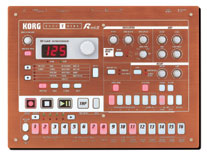 The intuitively designed Electribe•R mkII is packed with fat, innovative sounds produced by DSP synthesis technology, a classic interface for creating beats and tweaking them in realtime, and the ultimate array of up-to-date dance styles. The built-in step sequencer's 16 pad keys make it easy for you to produce rhythms from the sounds you create. Each pad keys lights up so you can easily see what rhythm a part is programmed to play. Plus, you can play in beats in real-time using the 12 trigger pads. Four of the pads are assignable to any analog modeling sound you come up with, two are reserved for controlling sounds accessed through the audio input, and the other four permanently control the indispensable PCM sounds. So you can tailor your own custom "kits" to fit each musical situation. Korg EMX-1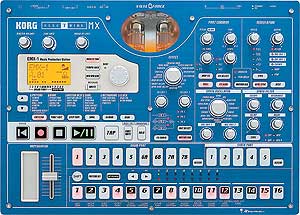 The ELECTRIBE·MX represents a new generation of Electribes – powerful dance music products that cover everything from laying down stunning tracks to creating exhilarating live performances. Oberheim DX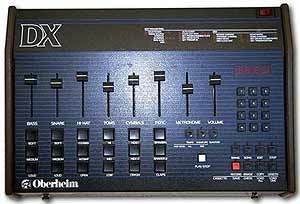 The DX was a lighter version of the classic DMX drum machine. In fact its look, features and programming method are basically the same as the DMX. The DX has individual tuning knobs for the drum tones and an external trigger input. Its sounds are sampled recordings of actual instruments. The DX only has 18 drum sounds. Both drum machines have a number of human like feel effects such as a great swing function, rolls, flams and other weird time signatures and grooves. Best of all it's easy to operate. There are also 6 individual outputs for easing studio use. It has been used by Hip Hop artists since the very beginning of Hip Hop! It has been used by Apollo 440, Daft Punk, and Jimi Tenor. Casio RZ-1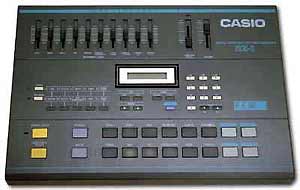 This drum machine is unique because it was one of the first to have an onboard editable sampled drum beat. Up to 4 seconds could be recorded with a mic in port. Each drum sound has its own audio out ports with volume knobs. Pretty basic sounds, as classic drum as it gets. Produced in 1985. It's been used by Autechre. Ritm-2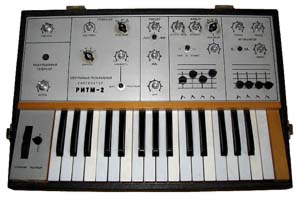 Made by Kirovsky musical instruments' factory in 1984 the EMI Ritm 2 is an one-voice keyboard synthesizer designed for solo, ensembles and orchestral playing musical compositions of any genre. It can be used both for educational needs and creating different musical effects. This synthesizer can be used with an acoustic amplifier which has a response of 0,775. There is a possibility to use a low frequency amplifier such as radio receiver, TV and tape recorder. The quality of the sounding depends on an acoustic amplifier. The synthesizer Ritm-2 can play soundings of the other classical instruments (keyboard, strings, reed and percussion instruments). It is intended for creating some specific sounds (wind, noise of surf, train, gun and whine). Using this instrument one can play some compositins with a random pitch and a timbre. Casio PT-50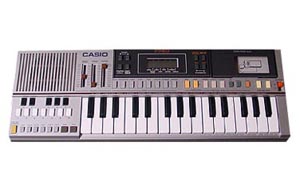 Second best machine from the PT-series (1983). A cool silver sequel to the very similar white PT-30. Warm and great rhythm sounds and some great rhythm/chord pattern too. Plays ROM Cards - and CASIO made many of them with stored arrangements. Formanta UDS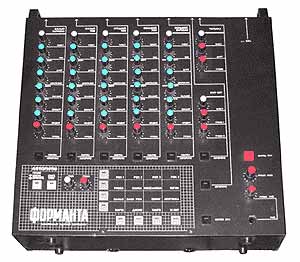 Soviet analog drum module from the 80's. Roland TR-606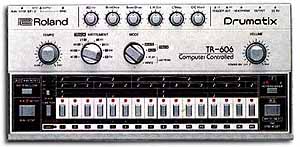 The 606 has seven analog drum sounds which are simple, yet great! Kick, Snare, 2 toms, open hat, closed hat, cymbal, accent. The hi-hats are a very tinny electronic sound and its toms are great for soft tribal patterns. These seven sounds alone are still quite popular today, and the 606 has been used by Uberzone, Cirrus, Sneaker Pimps, Download, Aphex Twin, Astral Projection, Nine Inch Nails, Mr. Oizo, Jimi Tenor, Kid 606, OMD, Moby, Freddy Fresh, Autechre, Luke Vibert, and Union Jack. Vermona Synthesizer It is one of the only analog synthesizers produced by German music company Vermona throughout the 1980's. It is a 2-VCO monophonic analog synthesizer. It has most basic analog edit parameters. A 24 dB/oct analog VCF filter with 4 knobs (Brilliance, CutOff, Resonance, Contour), a single LFO to modulate the VCO or VCF sections and a typical ADSR VCA envelope. There are preset VCF and VCA settings as well as a Manual mode, but there is no real Patch setting storage available. Also absent are MIDI and CV or Gate. Electron SidStation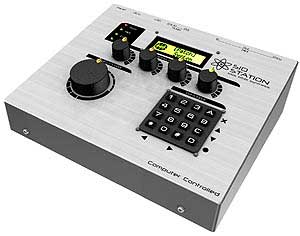 The Sidstation is a MIDI-controlled synthesizer with real-time controllers. The heart of this synthesizer is the sound generating chip from the classic home computer Commodore 64. This sound chip, named SID (Sound Interface Device) was developed in the early eighties by Bob Yannes at MOS technology. The rediscovery of the SID-sound will be a pleasant surprise for many sound explorers that are looking for something more exiting than the current crop of analog imitating 'virtual' synthesizers. Features of the Sidstation synth module include a rotary wheel for easy data entry, an alpha-numeric 2x16 LCD display with back-lighting, audio input andoutput, 3 syncable oscillators with traditional (triangle, sawtooth, pulse) waveforms, nice resonant filters, arpeggiators, effects and ring modulation. The numeric keyboard and large knobs offer a unique form of hands-on desktop dance / techno music production for the 90's and beyond! Casio MT-600 Casio MT-600 is a preset version of the DCO analog synth which uses SD synthesis (Spectrum Dynamic). It's a home-keyboard/workstation with built-in 8-bit PCM drum machine and accompaniments. Ensoniq Fizmo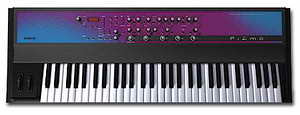 The Fizmo is a 48-voice synthesizer which uses 2nd-generation Transwave technology to create very organic sounds unlike any other synth available. Every programming function has its own dedicated knob or button, and there is a limited but useful 4-character LCD display. The Fizmo features an Arpeggiator and 24-bit VLSI effects with 41 algorithms, including a Vocoder and the ability to process incoming audio through the Vocoder and effects. Transwave synthesis uses wavetables of sound data with layered variations in harmonic structures such that their timbres progress naturally from one end to the other. This allows for sounds to modulate over time, or by velocity, wheel, pressure, or any number of other options. There are 2 oscillators available for each of the 4 presets allowing for 8 unique oscillators at the same time, not to mention individual LFO and Noisegenerators for each Osc. Another wonderful feature is the ability to stack up to four individual presets together into one sound and map them across the keyboard. This synth is very capable of some very complex sounds. Atari ST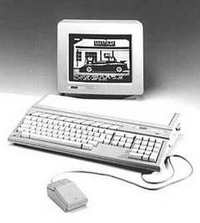 The ST was the first home computer with built-in MIDI ports, and there was plenty of MIDI-related software for use professionally in music studios, or by amateur enthusiasts. The popular Windows/Macintosh applications Cubase and Logic originated on the Atari ST. Even today some people (such as Fatboy Slim) are still using the Atari ST for composing music. Music tracker software was popular on the ST aiding the production of quality music from the Yamaha synthesizer ('chiptunes'). An innovative music composition program that combined the sample playing abilities of a tracker with conventional music notation was called Quartet . Due to the ST having comparatively large amounts of memory for the time, sound sampling packages became a realistic proposition. In addition to the sound sampling functionalities, the availability of software packages with MIDI support for music composition and efficient sound analysis contributed to make the Atari ST a forerunner of later computer-based all-in-one studios. Ritm-1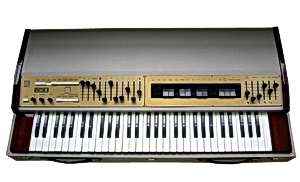 Soviet vintage analog organ with a built-in rhythm box and auto-accompanied styles which was pretty unique in its days. Casio-SK1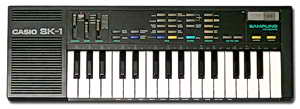 Well, people call it the poor man's sampler. It is the cheapest sampler in the world. Followed by the SK-5, the second cheapest in the world. Its strength is sampling and its weakness is just about everything else. It's monophonic and has just four-note polyphony. The sampling is 8-bit PCM, 9.38kHz, giving about 1.4 seconds. It's so gritty... Also, its memory clears when turned off. Obviously it's designed as a cheap toy for consumers. This is the sort of sampler-toy you end up belching into with your friends and play burp-songs for a laugh! The keyboard uses mini plastic keys. It lacks MIDI, lacks effects, edit-ability, memory, and filtering. However there are 13 envelope shapes that can affect your sample somewhat. There is also portamento, vibrato, and chord accompaniment with the chord selector system. If you gotta make some lo-fi cheese samples then you might want to try the SK-1, after all it is very cheap! It's used by Fatboy Slim, Beck, Autechre, Portishead, Blur, Bloodhound Gang, Nine Inch Nails, Tom Waits, Red Hot Chili Peppers. Kurzweil PC1X With an 88-note weighted action and 512 on board programs, the PC1X comes loaded, with Kurzweil's acclaimed Orchestral ROM expansion and full GM 1 compatibility included. For even more sounds, there's an expansion slot for Kurzweil's new Classic Keys ROM Soundblock. The PC1X's excellent sound is complimented by a dual effects processor (based on KDFX), an arpeggiator, and intelligent MIDI implementation. Akai S-900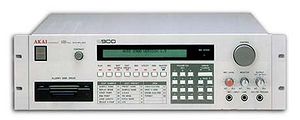 The S-900 sampler was Akai's first truly professional sampler, released in 1986. Its sampling specifications were pro-quality at the time: 12-bit stereo sampling, 7.5kHz to 40kHz variable sampling rates and a maximum of 63 seconds of sample time at 7.5kHz. Up to 32 samples can be created and stored to disk along with any edit settings. This was one of the first rack-mount samplers to use a built-in disk drive. Although the drive could load sounds while you play, it was still a very slow process. The S-950 soon followed the S-900 and offered increased memory and sampling rates. The sample rate was now variable from 7.5 to 48kHz and it could hold up to 99 samples in memory. Memory could be expanded from 750KB to 2.25MB. The S-950 is used by Fatboy Slim, Moby, Skinny Puppy, Depeche Mode, Future Sound of London, Sneaker Pimps, The Bomb Squad, Dr. Dre, DJ Premiere, Prince Paul, Digable Planets and A Guy Called Gerald. Akai XR10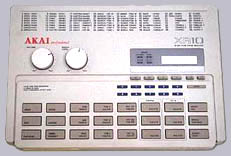 AKAI XR10 is a very cool 16-bit PCM drum machine. It is used by Peter Gabriel, Robert Palmer, Jam and Lewis, Simmons, and others. Casio Casiotone 1000P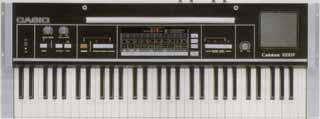 Casiotone 1000P is an 8-polyphonic additive synthesizer. One of the first generation of Casiotones from the early 80's. Casio HT-6000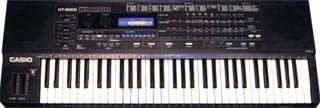 HT-6000 is the high-end version of CASIO HZ/HT series, the Spectrum Dynamic (SD) synths line. It was released in late 1987 and lasted until 1991. Although it looks like a boring home keyboard it's actually a fairly sophisticated synthesizer with some very unusual features. Roland JD-800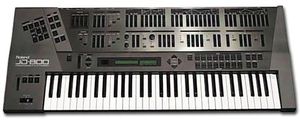 The JD-800 is Roland's answer to half a decade of hard-to-program synthesizers. Covered in sliders that act as dedicated editors just like a classic analog synth, the JD-800 is an extremely programmable and hands-on digital synthesizer. It is also an interesting and great sounding digital synth with incredible flexibility and control. Internal ROM based waveforms are combined to build your sounds. The sounds are based on Roland's D-50, but updated for the nineties with multimode filters - uncommon but welcome at the time. Unlike classic synths that came in wood cases, the JD-800 came in a somewhat cheap plastic case and wasn't very sexy. Programming is a little too scientific for most but once you know what you're doing with it, almost any sound you can dream up can be dialed in and stored. It's used by William Orbit, Emerson Lake & Palmer, 808 State, Ken Ishii, Astral Projection, Rabbit in the Moon, Depeche Mode, Underworld, Tangerine Dream, LTJ Bukem, Apollo 440, Jean Michel Jarre, ATB, Vangelis, Pet Shop Boys, Faithless, Luke Vibert, Mouse on Mars, Laurent Garnier, MC Hammer, Bushflange, Genesis, and Eat Static. Casio CZ-101 It's small, it's cheap, and it's good! This is the pea-size version of the CZ-1000 with a mini-keyboard. The CZ-101 is a digital synth and although the programming is somewhat limited there are plenty of analog-like traits and sounds to interest most anybody. It has a good 8-stage envelope design and uses Phase Distortion (PD) synthesis which gives it some pretty great sounds. The sounds are very similar to the Yamaha DX synthesizers, and they're much more affordable. PD is Casio's own take on digital synthesis from the mid-eighties and is found in all of their CZ series. You basically modify digital waveforms (sine waves) to create various sounds. It can create wild new sounds, notably percussive sounds. But it's not too easy to program if you don't know much about waveform theory and design. The CZ-101 has been used by Cirrus, Moby, Jimi Tenor, Vince Clarke, Jimmy Edgar, and They Might Be Giants. Atari 65XE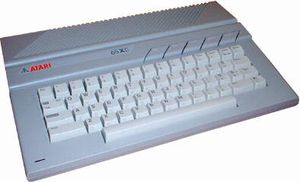 Atari brother to Commodore 64. Greath 8-bit computer, although with no MIDI. Roland CR-8000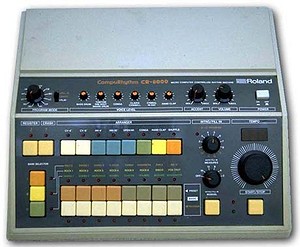 Well the sounds are great! Classic electronic drum sounds that hint back to the famous CR-78 and TR-808 drum machines. But none of these sounds are editable and there is only one mono audio output making this machine less of a studio-piece of gear and more of a collector's item. Aside from these limitations it, like other CompuRhythms, has a series of preset patterns in many different styles as well as programmable patterns with 8 storage patches. While the CR-8000 is usually sampled for today's applications, the thing about the CR-8000 that cannot be captured by sampling the sounds is the swing/groove feel which has its own control knob. The intervals between beats are variable, but also the timbre changes... very nice, especially the hats! It has been used by Fluke, BT, Jimmy Edgar, and Blondie. Korg ESX-1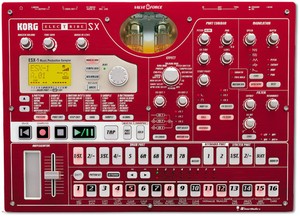 The ELECTRIBE-SX is a major step up in power and quality from the original Electribe series of dance music sequencer/synthesizers from Korg. The ESX-1 comes in a sturdy metal chassis with larger back-lit LCD display, expanded memory, voices & multitimbrality, more real-time controllers and vacuum tubes! Effects, Motion Sequencing, and Pattern length have also been expanded. And a new ribbon controller and slider have been added, providing a remarkable realtime interface for accessing the powerful arpeggiator. Korg Z1 Could this be Korg's masterpiece? The Z1 is like a polyphonic Prophecy! It does all the analog sounds and more. This is a great analog modeling synth with 12-voice polyphony, thirteen waveforms, four LFOs, two resonant filters, two effects units and more. The ability to create unique sounds is endless. The factory patches could use some help, but overall the sound is very nice! It has a fully polyphonic arpeggiator that blows all others away. It has five preset arpeggio patterns and fifteen user patterns. Unfortunately there is no on-board sequencer. There is incredible real-time control available with knobs to control the two resonant filters, and a touch controlled 'XY' pad for tweaking patches in real-time. The Z1 is used by KMFDM, Gary Numan, LTJ Bukem and Orbital. Yamaha QY100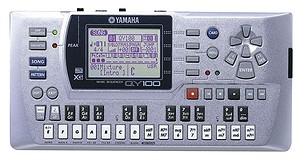 16-track sequencer, 525-voice tone module, unmatched automatic accompaniment features and more all rolled into one! The QY100 is a complete mini-studio for accompaniment and electronic music production that you can use just about anywhere — at home or on the road. Solton Ketron MS40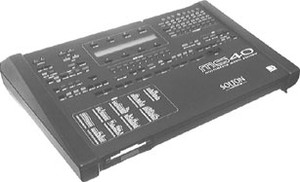 Keyboards and modules with built-in auto-accompaniments have always been treated as a bit of a joke by serious musicians, but are those attitudes now out of date? Ketron Lab have been making musical instruments for many years, mainly for the home and cabaret markets, but with the introduction of the MS series, they may have come up with a line deserving of a wider audience. The MS40 sound module under review offers an 'instant gratification' Style generator/creator, scads of wonderful sounds (even the usually mundane GM set is worthy of attention), a generous backlit 40x2 display, basic MIDI recording, and an integral DSDD disk drive. Korg EX-800 During the time of the Roland Juno series in the mid-80's, Korg offered the Poly-800. Comparable to the Juno and in many ways better, the Poly-800 is an 8 voice polyphonic analog synthesizer with 64 memory patches and up to 50 editable parameters! There's also a stereo chorus effect, a sequencer, and a weird joystick used to adjust pitch, modulation and the filter. There is a double mode in which the oscillators double up making 4 fat voices of polyphony - fun for trance and techno. The rackmount EX-800 version has a built-in 256-step polyphonic sequencer. Poly-800s have been used by Orbital, Depeche Mode, Sneaker Pimps, Vangelis, Geoff Downes, Yesterdays and Jimi Tenor. Casio VL-1 This seemingly worthless synth/calculator hybrid weighing in at under a pound has somehow found fame and fortune despite looking like a kid's toy. Its ultra cheesy sounds have been discovered and immortalized in the hit songs of such artists as Trio for "Da Da Da" and White Town. The Casio VL-1 or VL-Tone as it's also called has 29 little calculator-type button keys, five preset and one user memory patches, built-in rhythm machine (waltz, swing, rock, samba, etc.) and a 100-note sequencer. There is no chance at any external or MIDI control and there are no filters or effects. There is an LFO with vibrato and tremolo effects and an ADSR envelope. The tinny monophonic blips and beeps that come out of the VL-1 provide a childishly funny accent to your music, if you're into that sort of thing. The VL-1 is analog, it's tiny, it has a built-in speaker and a useless built-in calculator. The synth itself is quite small, light-weight and portable when running on batteries. The keys are unreliable and cheap soft buttons with absolutely no natural feel, response, aftertouch or velocity. The VL-1 was succeeded by the VL-10 (same spec, smaller case)and VL-5 (4-note polyphonic version with a useless bar-code reader). Strangely, the simple cheesy sounds of the VL-Tone have been used by Apollo 440, Devo, the Talking Heads, the Cars, Dee-Lite, Sting, Stevie Wonder, Vince Clarke, Beastie Boys, The Human League, Trio,White Town, and Bill Nelson. Casio Casiotone 701 The Casiotone 701 is a large full-size wooden keyboard with 61 full-size keys and a melody guide key lighting feature with barcode pen and sequencer. 20 Preset sounds include Brilliant Organ, Woodwind, Full Tibias, Piccolo, Jazz Organ 2, Electric Piano, Marimba, Chime, Bassoon, Wah Brass, Pipe Organ, Diapason, Tibia, Flute, Jazz Organ 1, Piano, Vibraphone, Celesta, Oboe and Funky. Has onboard Casio-chord feature and drum machine accompaniment. Also it can read music from barcodes! Roland SH-1000 The SH-1000 was Roland's first instrument, and probably one of the first Japanese compact affordable keyboard synthesizers. There are big ugly buttons typical of organ synths at the time. However this synth is more capable of monophonic bass like and lead sounds. Basic square, ramp and PWM waveforms are available. There are 10 preset sounds which are pretty unusable, and although there is no user memory, unique sounds can still be quickly recreated or discovered. It has a 'growl' and 'wow' effect for a pretty scary analog sound. It also features white noise, pink noise, portamento, octave transposition and a random note generator. In retrospect, the SH-1000 is ugly, its capabilities are limited, it's un-intuitive to program, it's a dinosaur! But it's also a classic piece of Roland's history. It has been used by Vangelis, Human League and Jethro Tull |
All texts and images are taken from www.ruskeys.net and www.vintagesynth.com

